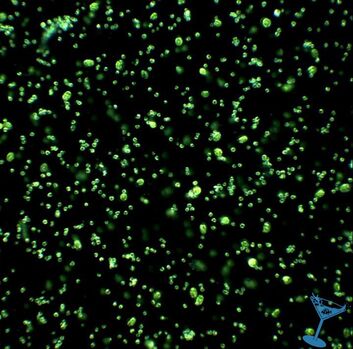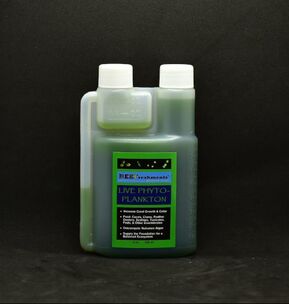What is Phytoplankton?
Nutritional Value of PhytoplanktonPhytoplankton is an abundant source of macro- and micronutrients, including: Protein, carbohydrates, vitamins, lipids, and trace elements. Arguably one of the most important nutrients contained within phytoplankton cells are lipids, in particular Omega-3 fatty acids. Omega-3 fatty acids, often referred to as highly unsaturated fats (HUFA), are absolutely essential for the health and coloration of marine invertebrates and fish. Of these fatty acids, eicosapentaenoic acid or EPA (found generally in green-colored phytoplankton species) and docosahexaenoic acid or DHA (found generally in brown-colored phytoplankton species) are of critical importance to marine life, with DHA proving to be the more essential of the two. When dosing phytoplankton in an aquarium, in order to obtain maximum nutrition, dosing multiple species with various nutritional profiles is important. A good dosing regimen for a reef aquarium is a MINIMUM of one species of a high-EPA (e.g., Nannochloropsis) and one specie of a high-DHA algae (e.g., Isochrysis) to ensure that the aquarium inhabitants receive proper nutrition. What Consumes Phytoplankton?In both the wild and in aquariums, phytoplankton is a perfect food for: Corals, clams, feather dusters, scallops, tunicates and sponges, copepods, tube-worms, sea squirts, and other suspension-feeding invertebrates. In aquariums, regular dosing of phytoplankton increases the health, coloration, growth, and polyp extension of corals, increases the development and vibrancy of your marine life, and boosts zooplankton populations. You can view our Live Feed Guide for a more thorough breakdown of the marine life that benefit from phytoplankton dosing. Maintaining Water QualityPhytoplankton play a major role in water quality and nutrient recycling through their consumption of nitrogenous wastes. Nitrogen and phosphorous are required by the phytoplankton to perform photosynthesis. In an aquarium environment, adding live phytoplankton will reduce your nitrate (NO3) and phosphate (PO4) levels as the living phytoplankton consume these nutrients for photosynthesis. Not only will live phytoplankton help reduce NO3 and PO4 levels, but through photosynthesis the phytoplankton help balance pH levels by increasing dissolved oxygen levels in the aquarium while simultaneously reducing carbon dioxide levels. How drastically can phytoplankton affect water quality? It turns out, quite a lot! In fact, because phytoplankton are so effective at nutrient uptake and because of their capacity for exponential growth, phytoplankton are sometimes utilized at municipal water treatment facilities to remove primary nutrients from sewage and wastewater. So, if phytoplankton can tackle sewage, just imagine the work that phytoplankton can do in your aquarium! Outcompeting Nuisance AlgaeA further benefit of dosing live phytoplankton in an aquarium is to help reduce or prevent nuisance algae growth (e.g., hair algae, bryopsis, cyano, etc.). Nuisance algae in aquariums require the same nutrients as live phytoplankton to grow and survive. If live phytoplankton is dosed regularly and consumes these nutrients, the nuisance algae will eventually wither away. What to Look for in a Quality Phytoplankton ProductThere are a lot of phytoplankton products on the aquarium market, and there is a lot of misinformation about what constitutes a quality phytoplankton product. If you are looking for a quality phytoplankton product that will give your reef the benefits of maximum nutrition, optimal water quality, and help reduce nuisance algae growth, then here's what you need to look for:
***For proper nutrition, you need to dose a MINIMUM of TWO species of phytoplankton.***
***It is critical to dose BOTH high-EPA (typically "green") and high-DHA (typically "brown") species.***
***In order to receive the benefits of nutrient consumption, the product must be LIVE.***
***Avoid products with additives that could be potentially harmful to your reef.*** REEFreshments®: Live Phytoplankton
References[1] Delbeek, J. C., & Sprung, J. (2005). The Reef Aquarium: Science, Art, and Technology. Ricordea Pub. [2] Hentschel, B. T., & Shimeta, J. (2008). Suspension Feeders. Encyclopedia of Ecology. [3] Hoff, F. H., & Snell, T. W. (1987). Plankton culture manual. Florida Aqua Farms Inc. [4] Levinton, J. S. (2009). Marine Biology: Function, biodiversity, ecology. Oxford University Press. [5] Wittenrich, M. L. (2007). The complete illustrated breeder's guide to marine aquarium fishes. T.F.H.
0 Comments
Your comment will be posted after it is approved.
Leave a Reply. |
Aquaholic BlogOur blog is dedicated to educating aquarium hobbyists about all-things-aquaculture, as well as sharing our aquatic adventures at Aquaholic Aquaculture® with fellow #Aquaholics Archives
February 2023
Categories |



 RSS Feed
RSS Feed